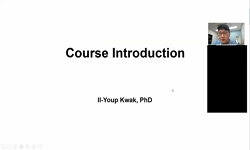






| 1. |  |
수업 설명, Colab 설명 | 수업 설명, Colab 설명 |  |
 |
Chapter 1 Machine Learning Landscape | 1. Types of Machine Learning system 2. Main challenges of Machine Learning, 3. Testing and validation |  |
|
| 2. |  |
Chapter 2 End-to-End Machine Learning Project | 1. Look at the big picture 2. Get the data 3. Discover and visualize the data to gain insights 4. Prepare the data for Machine Learning algorithms |  |
| 3. |  |
Chapter 2 End-to-End Machine Learning Project | 5. Select a model and train it 6. Fine-tune your model |  |
 |
Chapter 3 Classification | 1. MNIST data 2. Training a Binary Classifier 3. Performance Measures 4. Multiclass Classification 5. Multilable Classification |  |
|
| 4. |  |
Chapter 4 Training Models | 1. Linear Regression 2. Gradient Descent 3. Polynomial Regression 4. Learning Curves 5. Regularized Linear Models |  |
| 5. |  |
Chapter 5 Support Vector Machines | 1. Linear SVM Classification 2. Nonlinear SVM Classification |  |
 |
Chapter 5 Support Vector Machines | 3. SVM Regression |  |
|
 |
Chapter 6 Decision Tree | 1. Training and Visualizing a Decision Tree 2. Making Predictions 3. Estimating Class Probabilities 4. The CART Training Algorithm 5. Regularization Hyperparameters |  |
|
| 6. |  |
Chapter 7 Ensemble Learning and Random Forests | 1. Voting Classifiers 2. Bagging and Pasting 3. Random Forests 4. Boosting 5. Stacking |  |
 |
Chapter 8 Dimensionality Reduction | 1. The Curse of Dimensionality 2. Main Approaches for Dimensionality Reduction 3. PCA |  |
|
| 7. |  |
Chapter 8 Dimensionality Reduction | 4. Kernel PCA 5. Locally Linear Embedding (LLE) 6. Other Dimensionality Reduction Techniques |  |
 |
Chapter 9 Unsupervised Learning Techniques | 1. Clustering 2. Gaussian Mixtures |  |
|
| 8. |  |
Chapter 10 Introduction to Artificial Neural Networks with Keras | 1. From Biological to Artificial Neurons 2. Implementing MLPs with Keras |  |
| 9. |  |
Chapter 10 Introduction to Artificial Neural Networks with Keras | 3. Fine-Tuning Neural Network Hyperparameters |  |
 |
Chapter 11 Training Deep Neural Nets | 1. The Vanishing/Exploding Gradients Problems 2. Reusing Pretrained Layers |  |
|
| 10. |  |
Chapter 11 Training Deep Neural Nets | 3. Faster Optimizers 4. Avoiding Overfitting through Regularization |  |
 |
Chapter 12 Custom Models and Trainingwith TensorFlow | 1. A Quick Tour of Tensorflow 2. Using Tensorflow like Numpy |  |
|
| 11. |  |
Chapter 12 Custom Models and Trainingwith TensorFlow | 3. Customizing Models and training algorithms 4. Tensorflow functions and graphs |  |
| 12. |  |
Chapter 13 Loading and Preprocessing Data with TensorFlow | 1. Data API 2. TFRecord Format 3. Preprocessing the input features 4. TF transform, TF Datasets |  |
| 13. |  |
Chapter 14 Deep Computer Vision Using Convolutional Neural Networks | 1. Convolutional Layers 2. Pooling Layers 3. CNN Architectures 4. Implementing a ResNet-34 CNN using Keras |  |
| 14. |  |
Final Presentation 1 | Final Team presentation |  |
 |
Final Presentation 2 | Final Team presentation 2 |  |
